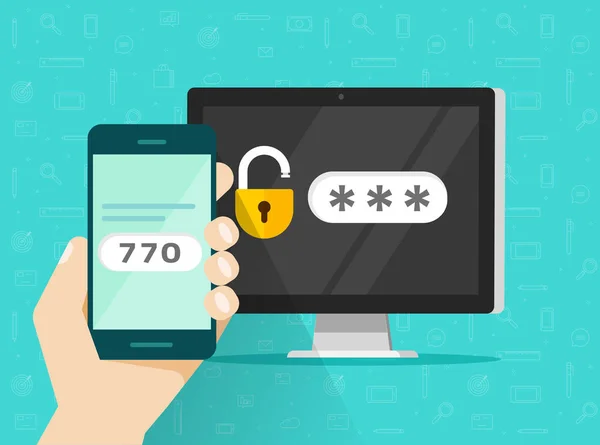Internet security has been evolving since the start of the Internet in 1983. Since then, there have been many successes and failures when it comes to securing personal details, such as financial information, addresses, phone numbers, etc. According to techjury.net, globally, 30,000 websites are hacked daily, and 20 MILLION breached records were made in 2021. Now, more than ever, there is an increased need for extra protection on accounts, especially since malware is easily accessible from various websites, and 300,000 pieces of malware are created daily. Here is where something called Two Factor Authentication steps in.
Two Factor Authentication is a secure identification system designed for users to verify themselves via authentication systems such as QR codes, SMS, and calling just to name a few. According to newamerica.org, Two Factor Authentication was invented in 1986 and was made commercially available by the RSA company as a key fob, a small handheld remote control device. It was mainly used by large enterprises and governments and was not a common feature on the internet until 20 years later, where the need was increased because people using account-based services had a large number of their accounts being hacked, and hacking overall was at an all-time high. Google was the first company to unveil their two-factor authentication system in 2011, caused by a targeted attack by the Chinese government towards Google which made them increase their security. In years since, Microsoft, Twitter, Apple, and a multitude of other companies have followed suit, showcasing their Two Factor Authentication System.
Two Factor Authentication has loads of benefits, one being that the average person is unable to be hacked as easily, and a hacker is unable to access all your info without being stopped at the authentication screen. It provides benefits to the end-user because it helps let users know that their personal information is safe, and in case of a data breach, hackers would be unable to log in to your accounts unless they had access to some sort of authenticator. Those include Google Authenticator, where a code would be generated on the app and you would sign in from that, QR codes, where you could have to scan via your mobile device, Backup codes in case you are unable to access your mobile device, phone number calling and texting, and Email authentication. Also, some companies are leaning towards physical characteristics like using voice recognition to determine if it is you or not, as well as using Face ID, which will scan your face, and Touch ID, a fingerprint system that will determine if it is you or not via using your fingerprint. However, some scammers may try taking advantage of you, and attempt to gain access to your account…
There are certain risks involved with Two Factor Authentication. One of them is that scammers and hackers alike will try to gain access to your banking information by impersonating bank associates, and high corporate level positions to try and convince you that they are trustworthy, and can handle your information securely. This is known as social engineering, a deception tactic used to manipulate individuals into giving them confidential or personal information to be used for fraudulent purposes. These scammers will try to use your information by either selling it to companies so that they can spam advertise you with information, or they will try getting money off of you, ranging from 500 USD to 50,000 USD depending on the person & scammer. They can also attempt to Sim Swap, tying in with social engineering by calling your mobile network provider pretending to be you, and trying to get your number on their sim card instead. Also, many users have complained that Two Factor Authentication is a laborious process, and is an extra step for the signing-in process. Many companies have even gone as far as to automatically log you out for security reasons, which has been reported as a hassle, and an annoyance for others. Also, many users have reported losing their 2FA credentials and One last risk is that websites can store 2FA data in session cookies, which a hacker can sniff out via developer tools, and a hacker can bypass 2FA overall, and get into the account.
So, how can YOU stay safe using Two Factor Authentication? Well, make sure that all your 2FA credentials are up to date, and make sure that you have very secure passwords, to begin with, in case of a breach or attack. Never use the two same passwords on one account, and you can use a service like LastPass, which will let you generate a unique, secure password that will autofill every time you attempt to sign in. Always be aware of scams, since NO company will EVER ask you for passwords to your accounts, nor should anyone watch you log in to your account. Never share your passwords with anyone, and no company will ever CALL you saying that you have a virus. If you have a virus, always have antivirus software on you at all times to get rid of it, such as Malwarebytes. Of course, there is no foolproof way to make sure your accounts will never be accessed without authorization, but 2FA will lower that risk drastically. Remember, the more ways of authentication, the better. Always have the MOST SECURE way of authorization. Sure, it may be a hassle, but it will better protect you and hackers will be unable to obtain access to your information. All in all, make sure to have 2FA on for every website you visit.
It is important to know how to stay safe on the internet, and since the scamming industry is a ONE BILLION dollar industry, it is good to know how to protect yourself from scams, since they can pop up anywhere and everywhere. Along with that, every 39 seconds, there is a new attack somewhere on the web, so you should never let your guard fully down. If you follow the right steps to protect your account from hackers and scammers, you will have a good time on the Internet. Many fall victim to hacks because of either the company’s fault in failing to secure databases or mainly the user’s fault in not taking the proper steps to secure their account, such as not having 2FA on. Please share this article with friends and family, and let them know about Two Factor Authentication since shares of this article can potentially save millions.

Source: Statista.com. Share of internet users in the United States who use two-factor authentication in 2010 and 2017, by method.



Leave A Comment